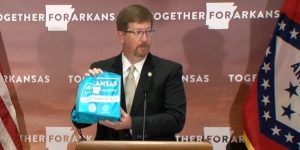Pandemic education: For Arkansas schools, it’s been a year like no other
by March 15, 2021 5:17 pm 1,734 views

Editor’s note: This is the second of four stories in a series about the first year of the COVID-19 pandemic in Arkansas. Link here for the first story.
John Goff says teaching math virtually to Bryant Junior High students isn’t the same as doing it in person. He needs to see the light bulb go off when they understand a concept. He needs to look at their paper to see how they’re working a problem.
“I believe as much as possible we are getting the standards taught, but it’s a much slower process,” he said. “It’s much, much slower. We don’t get as much accomplished in virtual as we do in class.”
For Goff and other Arkansas educators, the past 12 months have been like none other. On March 13, 2020, Gov. Asa Hutchinson closed school districts, including Bryant, in four counties at the beginning of the COVID-19 pandemic. On March 15, a Sunday, he closed all schools statewide for two weeks, and later he announced they would remain closed the rest of the school year.
Schools immediately pivoted to offsite instruction – done online where possible or using more old-fashioned alternative paper-based methods where not. The transition was made easier because many districts had already moved to “one-to-one” status where every student has a digital device. In Bentonville, students in grades 7-12 were already taking computers home at night, said the district’s superintendent, Dr. Debbie Jones. The Friday before the governor closed schools, the district sent home 10,000 Chromebooks in one day with younger students. Students in that district missed only one day of school.
Dr. Richard Abernathy, the recently retired former executive director of the Arkansas Association of Educational Administrators, said Arkansas was ahead of the game.
“When I talked to the former counterparts around the nation, they weren’t there. Technology-wise, they just weren’t there,” he said.
School districts had more time to plan for this school year after learning lessons from the spring semester. Bentonville found students benefitted from live, face to face lessons with their teachers using Google Hangouts, Jones said. Being present and participating in lessons improved academic performance, kept students connected, and kept them on schedule.

The percentages of students choosing to learn virtually versus onsite varied widely from district to district, but as of March 12, 80% were on site or in a hybrid situation, while about 20% were completely virtual, said Education Secretary Johnny Key. At the beginning of the year, it was 75-25, as some students have returned to the classroom.
How well students are doing often depends on those their characteristics and situations. The state Division of Elementary and Secondary Education has partnered with the Graduation Alliance to create the Engage Arkansas initiative to engage those students who are struggling at home. Key said a number of students were taking care of younger family members. Some have jobs, which limits engagement.
Abernathy said it’s unclear how much ground has been lost. The ACT Aspire tests given to all students were cancelled last year but will occur this year.
“We don’t have a real good feel,” he said. “We all suspect that we’re behind. We don’t really know how far behind. And like I said, some of our kids may not be.”
Conway Superintendent Dr. Greg Murry said it’s “inevitable” that students will be behind. The first nine weeks of the next school year will look very different as students return and teachers help students catch up, Murry said. Jones said onsite and virtual students in Bentonville have shown academic growth in tests, although there have been more “F’s” in students’ final grades. The virtual students’ test scores were “very comparable” to the onsite ones. She’s pleased, but she wants additional testing of virtual students to ensure they didn’t get help from their parents.
Bryant Superintendent Dr. Karen Walters is squarely in the camp of having students on site. She said students need to be around peers to learn social interactions, and elementary students need to learn phonics in person. Supports and therapies are not the same virtually. And some students from rough home situations need someone checking up on them. Walters estimates that 10% of her virtual students aren’t logging in and fully participating in their studies. With 1,500 virtual students, that’s 150 who are falling through the cracks.
As schools prepare for the next school year, they’ll have a big pot of money to work with. As a result of the $1.9 trillion stimulus package signed by President Joe Biden March 11, Arkansas schools will receive $1.2 billion, 90% of which will be distributed to school districts. Combined with previous packages, the department and schools will have received about $2 billion in federal funds, some of which doesn’t have to be spent until 2023. Some states will use the money to reopen schools, but Arkansas won’t have that expense. Key said a lot of districts will spend money on HVAC (heating and air conditioning) systems based on calls the department has been receiving. That was a component of the previous $550 million relief package as well.
But contractor capacity will be an issue. Moreover, there are still many unknowns. Abernathy said some schools have held off on construction projects because they don’t know what their enrollment will be. With more students learning virtually, districts may not need as many classrooms.
This is, of course, a public health crisis. The Department of Health reports that 28,513 students have been infected with COVID-19. No Arkansans under age 18 are known to have died, although Conway Superintendent Dr. Greg Murry said one of his students spent time in Arkansas Children’s Hospital. The Health Department says there have been 11,613 faculty/staff cases. Key said at least 20 have died. He mentioned longtime Norfork High School Principal Bobby Hulse as one of the losses.
“How do you balance that? … There’s not an equation for maybe we wouldn’t have had that many deaths if we had completely shut down schools,” he said. “Maybe. I don’t know. But I do know that if we had completely shut down schools, we would have created challenges for hundreds to thousands of our students that would have been very difficult if not impossible for them to overcome that would have lasting negative effects on their lives.”
Despite the health challenges, schools have largely stayed open. In Bentonville, the district had to pivot one fourth-grade class for a week, one junior high for four days, and in both high schools students were sent home for one week prior to Thanksgiving. Key is surprised schools haven’t had to pivot more often. Some school leaders have told him they haven’t pivoted to virtual learning once. The success in keeping schools open also was a surprise to Conway’s Murry, who said, “If you told me in September that we would still be in school, I would have said, ‘No, you’re wrong.’ I was betting on sometime the early part of September, the governor was going to tell us all to go home again.”
Abernathy serves on a national COVID task force without about 30 members. Some of his colleagues haven’t had students in school since last March. Some feared their teachers wouldn’t return to work and didn’t know how they would protect students. He would tell them Arkansas schools reopened in August.
“When I visit with my counterparts around the nation, we have done it, and we’ve done it right,” he said. “And they need to be looking at Arkansas to see how to move their state forward and get kids back in the classroom.”
In addition to the pandemic’s physical health challenges, schools also will have to address mental health. Ryane Sorey, Sheridan School District mental health coordinator, told the Arkansas School Boards Association in December that the pandemic has been traumatic for all students. They were in school one day in March 2020 and then left the classroom for the next six months.
“I’m not asking, you know, hey, have their grades dropped?” she said. “Or what sort of impacts do you see in the classroom? Because every single student has experienced a trauma, and so every single student is eligible for school-based mental health services through our district.”
What schools look like when the 2021-22 school year begins depends on the virus. Key said educators will listen to health experts. There could be ups and downs over the next few years. Districts will have to be ready to pivot if community cases rise. Bryant’s Walters believes students will still be wearing masks. As Murry put it, “If there’s another spike and our numbers start getting ugly again, and if we have to continue down the path that we’re on, all bets are off at that point.”
Schools must offer 178 days of instruction under the law, but they will be able to continue to offer blended or remote instruction programs as they did this year. In December, Key told the Arkansas School Boards Association that six aspects of digital programs are “non-negotiables.” The program must be planned with purpose; it must have high-quality content and instruction; students and teachers must have equity of access; teachers, students and parents must be offered support; there must be clear expectations, policies and guidelines; and school districts must plan for regular communication and interaction.
Bentonville will continue to offer virtual options for students, as it was before the pandemic started. In Bryant, for elementary students, virtual classes are being discouraged but nevertheless are made available. Virtual secondary students will attend Buzz Academy after completing an application process. Students who didn’t have good attendance this year won’t be able to choose that option. In Conway, no decision has been made about virtual options as the district prepares to replace the retiring Murry.
Virtual educational opportunities will be part of the landscape permanently in many districts. Looking to the future, some districts see virtual classes as part of their offerings while others will offer it because they fear they will lose students to school choice if they don’t, Key said. Some won’t offer it at all.
“I see innovation coming from what we’ve had to deal with,” he said. “I see schools rethinking how they have school, and doing so in a way that may be untraditional, but it might suit their communities moving forward.”
